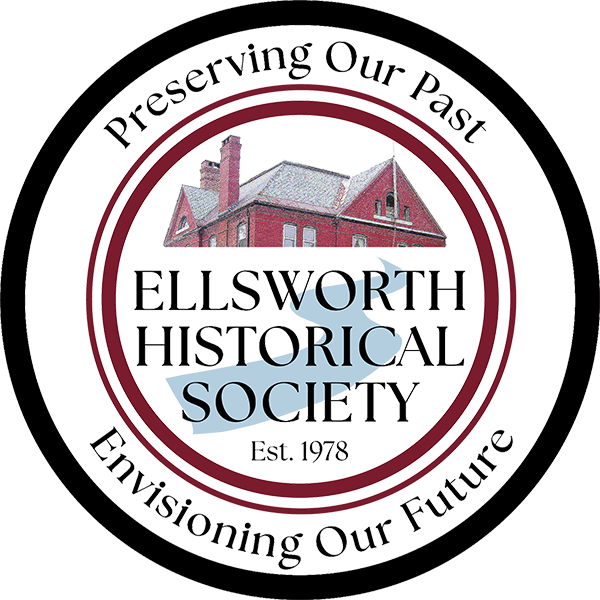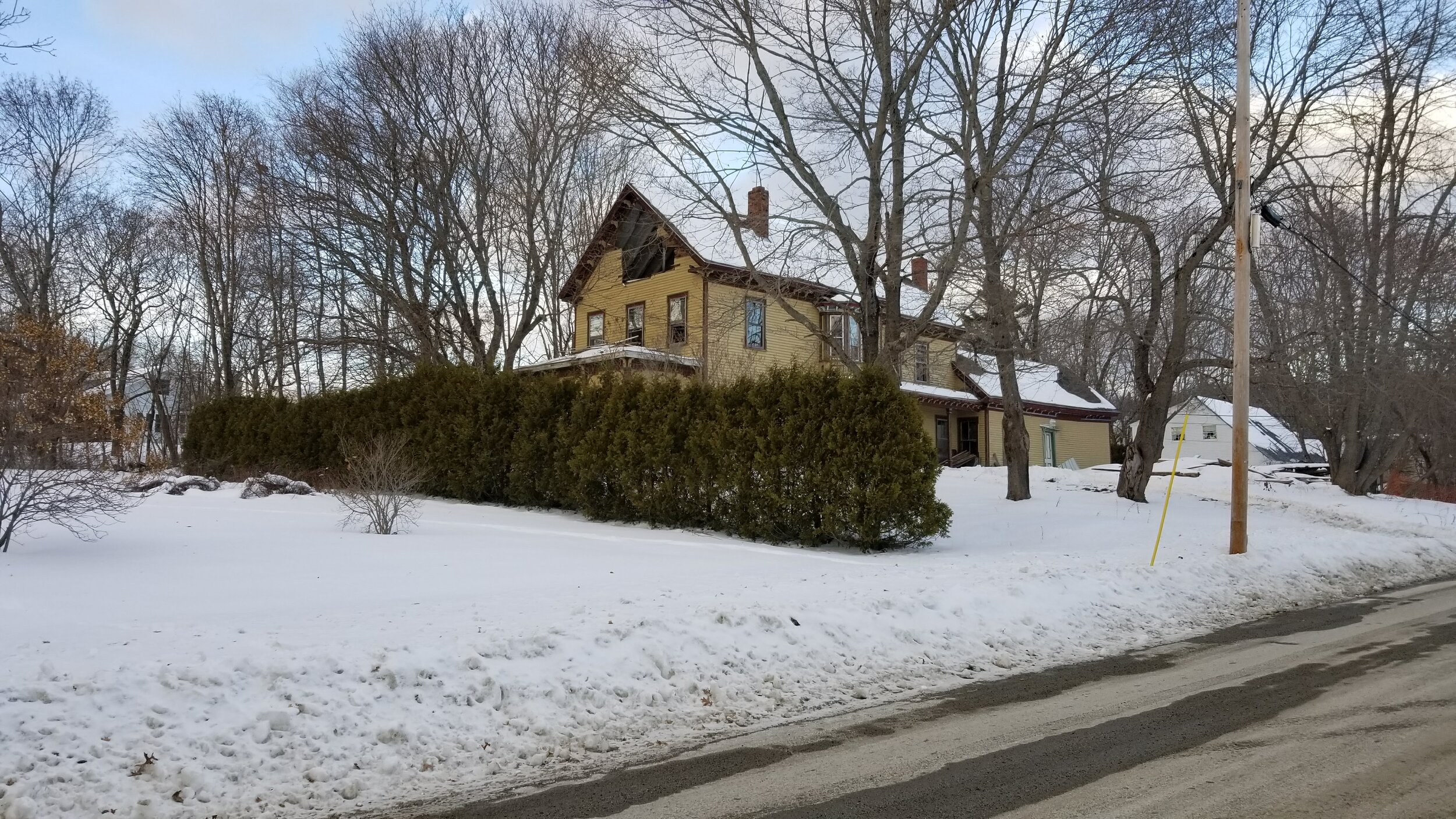Decline and Fall: The Changing Face of Downtown Ellsworth
64 Pine Street (from a 1949 assessor’s photo; the “28” is an assessor’s file number).
A study could (and, probably, should) be made of the fate of Ellsworth’s lovely and often grand old homes. The idea might emerge from that study that the Ellsworth boom of the mid- to late 1800s—which saw the construction of these impressive buildings—gave way to the decline of the city’s economy in the first half of the 20th century, and that these hard times resulted in deferred maintenance and, eventually, the dilapidated condition in which we observe many of these residences today.
Linda Dinsmore, Vice-President and Secretary of the Franklin Historical Society, will tell you that is certainly not what happened on Pine Street. Linda’s memories (from the 1950s and 1960s) are of lovingly maintained homes that were a source of pride for their owners. Her grandparents’ home—64 Pine Street—was always beautiful, especially at Christmas.
Several weeks ago, neighbors began noticing appalling changes to the elegant pale yellow house that has sat empty since the death of John S. Jerabek in December 2015. The original 4-over-4 windows have been smashed and removed, the hot air grates and other decorative elements have been ripped out, and the front door of the house stands wide open. Eventually it was learned that the property, along with 33 Spruce Street immediately behind it, had been sold to a developer. In February 2021, both houses were demolished.
64 Pine Street (top) in 2007 and (bottom) in December 2020.
Just as attention focused on this property, in a single morning the Wooster House at 73 Beal Street was suddenly razed. In both properties, long vacancy led to infestation by wild animals and deterioration by rain water and lack of heating.
Further down Pine Street, the famous Jordan House sags under successive winters, and in October 2018 the former 62 Deane Street was razed.
62 Deane Street (top; the “64” is an assessor’s file number) in 1949 and (bottom) in its final moments in 2018.
Skirt, White Blouse, and Sweater
Linda’s grandparents, Leon and Margaret S. Tilden, owned 64 Pine Street from 1956 to 1981. Leon was a house painter and Margaret worked at Union Trust Bank. Linda’s childhood friend Becky Donnell Grindle remembers Mrs. Tilden as an elegant figure:
I remember her coming home for lunch [from] work [and] walking up Pine always with heels on, skirt, white blouse, and sweater and a handbag. Her hands were always folded over, holding her bag. She was quite a lady.
Both women remember Ellsworth and, in particular, Pine Street as a place of well-maintained family homes, often passing from generation to generation.
Yet the question remains: what brought about the decline of these great old homes? Can the answer be generalized, or is it simply a matter of individual cases—some survived and some did not? The houses at 65 and 62 Pine Street were at some point placed on the local historic register. The unique brick home at 61 Pine is occupied and maintained. The jungle was cleared from around 45 Pine Street and it is now the law office of Chris Whalley.
As late as the 1970s, these homes appear to have been kept up. What happened, beginning in, say, 2000, that changed the fate of many of these old houses? Was it cultural, economic, environmental, or some combination of all of these?
Alice Carlisle’s house at 12 Park Street stares straight ahead, waiting for the wrecking ball—minus its large, decorative top window. January 2018.
64 Pine Street: Home, Parsonage, Boarding House, Restaurant, and Law Office
The first deed for the land later known as 64 Pine Street dates from 1859, when it passed from Monroe Young (who lived roughly where 57 Pine Street is today) to James H. Lord. In 1865 the land was sold to Hoyt H. Harden, who deeded it to (presumably) his son Artemis P. Harden in 1867. It is “A.P. Harden” who is shown in the 1881 Colby Atlas as the owner of a house on the property. The next door neighbor in 1881 is given as “J. Harden,” presumably another son.
Pine Street, from the 1881 Colby Atlas.
An Ellsworth American notice of October 1914 states that “J. W. Chase, of Bucksport, has purchased the A. P. Harden house on Pine Street, and has moved here with his family.” The deed also conveyed “the carpets now on the floor in the double parlors downstairs.”
The double parlor of 64 Pine Street in December 2020.
We learn from an August 1916 notice that James W. Chase and his wife Minnie sold the house to the United Baptist Convention of Maine. In 1930, some sort of internal arrangement was made and the house passed to the United Baptist Church of Ellsworth, who then sold it one year later to Daniel G. and Annie D. Young. Daniel had been elected Master of the Mariaville Grange in 1907 and won a ribbon at the Mariaville Fair in 1913 for the best cabbage. Sadly, the Youngs weren’t able to keep up their mortgage payments and the property went into foreclosure in 1937.
The next owners were Kermit J. and Loretta P. St. Peter, who lived in the house a little over 10 years then sold it to Daniel and Nora E. Orr, who operated the premises as a boarding house until they sold it to Linda’s grandparents, Leon and Margaret S. Tilden, in 1956.
Although Margaret occasionally rented a room to students, for the next 25 years the house was an elegant private residence remembered especially for its Christmas decorations, including a large tree in the side yard, decorated with lights, that faced Pine Street. The walls of the double parlor were papered with a green leafy pattern, and a fire was kept in the parlor closest to the Pine Street School; the other fireplace was simply there for the symmetry and did not have a fire box. Both had extraordinary marble surrounds rather than a wood mantlepiece.
Linda’s grandfather Leon mixed his paints in one of the rooms of the ell, and it was said that Leon never bore a paint stain on his clothes. He was able to match colors from memory, without reference to a chip. He died in 1966.
In 1981 Margaret sold the house to James A. and Mary R. Hart, who had been running a restaurant in Bar Harbor. They turned 64 Pine Street into a second restaurant, elegant and intimate, they called “The Carrying Place,” after a location on Swann’s Island. Unfortunately, Mary began to lose her sight, and keeping the two businesses became a struggle. They sold in 1985 to another food service company based in Milbridge called the Blueberry Goose Inc., who maintained their business on Pine Street for only two years. A woman named Martha L. Junkins bought the house in 1987 and sold five years later to the Lamoine attorney John S. Jerabek, who maintained the house as his professional office. When Jerabek died in 2015, a holding company purchased the property but kept it vacant. It was sold to a developer in December 2020 and razed.
The honey-colored floors, recently covered with snow blowing in through the shattered windows, are in a better condition than those in this writer’s home.
Entrance hall of 64 Pine Street.
A Divisive Subject
The preservation and restoration of old buildings is a subject that tends to polarize opinion. There is something of a hawk and dove mentality when the deterioration of an old building comes up on Facebook. The profound cost of restoration is sobering. The properties themselves, with their overgrown lots and bleak clapboards, become blights on the city’s face. And—for whatever reason—the millionaires seem to keep driving through town until they reach MDI.
In a December 2020 article entitled “Maine Can Finally Get Out of Massachusetts’ Shadow,” the Boston Globe noted:
Many of Maine’s towns and cities lacked the money to bulldoze their downtown cores in the mid-20th century, which means they still have the walkable 19th-century townscapes integral to 21st-century urban vitality.
This might be true of Camden, but it doesn’t quite describe the declining historicity of Ellsworth, a city that may have adopted a permanent policy of self-reinvention after the immolation of the 1933 fire.
It seems odd that today’s focus on urbanity and historic charm has not obtained a foothold in Ellsworth. Forces are at work within the city to foster this, for instance the downtown business organization “Heart of Ellsworth” as well as private architectural firms and even, to a certain extent, agents within the city government itself. However, this perspective is very late coming to Ellsworth, and for every person who is saddened by the plight of the Old Hancock County Jail there is another who would be glad to see it razed. Both argue convincingly.
In the end, the best approach may be one of triage: evaluating, prioritizing, and letting go only in the face of overwhelming evidence. The belief that the bustling, hyperactive present can be comfortably, even advantageously housed within the physical (and psychological, cultural) structures of the past may yet secure a recognizable, deeply historic face for downtown Ellsworth.








